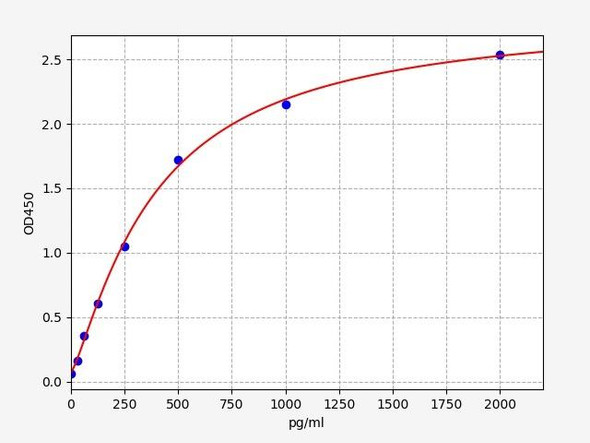Description
| Product Name: | Recombinant Cynomolgus Thymic Stromal Lymphopoietin/TSLP (C-6His) |
| Product Code: | RPES6774 |
| Size: | 10µg |
| Species: | Cynomolgus macaques |
| Expression Host: | E.coli |
| Synonyms: | Thymic stromal lymphopoietin, Thymic stroma-derived lymphopoietin, TSLP |
| Mol Mass: | 16.2 kDa |
| AP Mol Mass: | 16 kDa |
| Tag: | C-6His |
| Purity: | > 95 % as determined by reducing SDS-PAGE. |
| Endotoxin Level: | < 1.0 EU per μg of the protein as determined by the LAL method. |
| Bio Activity: | Immobilized Mouse TSLPR-Fc at 10μg/ml (100 μl/well) can bind Biotinylated Cynomolgus TSLP-His. The ED50 of Cynomolgus TSLP-Hisis 3. 2ug/ml. |
| Sequence: | Tyr29-Gln159(Glu37Gln) |
| Accession: | XP_005557555.1 |
| Storage: | Generally, lyophilized proteins are stable for up to 12 months when stored at -20 to -80°C. Reconstituted protein solution can be stored at 4-8°C for 2-7 days. Aliquots of reconstituted samples are stable at < -20°C for 3 months. |
| Shipping: | This product is provided as lyophilized powder which is shipped with ice packs. |
| Formulation: | Lyophilized from a 0.2 μm filtered solution of 20mM PB, 500mM NaCl, pH 7.4. Normally 5 % - 8 % trehalose, mannitol and 0.01% Tween80 are added as protectants before lyophilization. Please refer to the specific buffer information in the printed man |
| Reconstitution: | Please refer to the printed manual for detailed information. |
| Background: | Thymic stromal lymphopoietin (TSLP) is a protein belonging to the cytokine family, contains 140 amino acids. It is known to play an important role in the maturation of T cell populations through activation of antigen presenting cells. TSLP induces the release of T-cell-attracting chemokines from monocytes and, in particular, enhances the maturation of CD11c+ dendritic cells. It can induce allergic inflammation by directly activating mast cells. TSLP is produced mainly by non-hematopoietic cells such as fibroblasts, epithelial cells and different types of stromal or stromal-like cells. These cells are located in regions where TSLP activity is required. |






